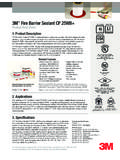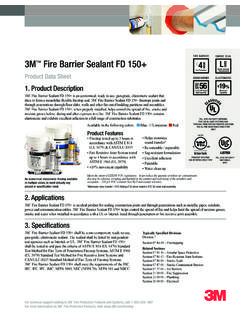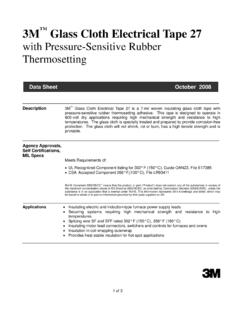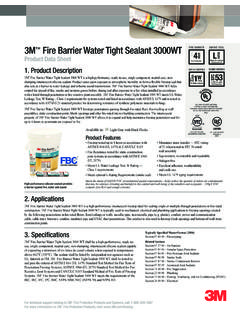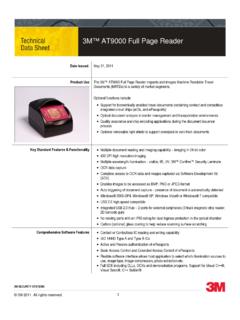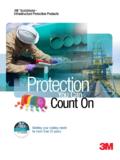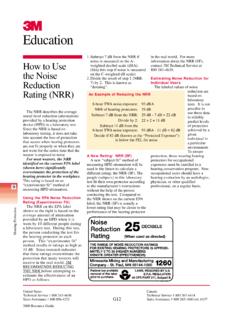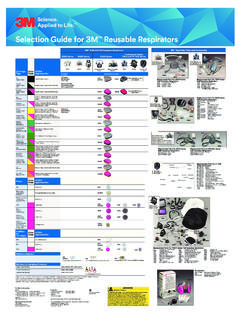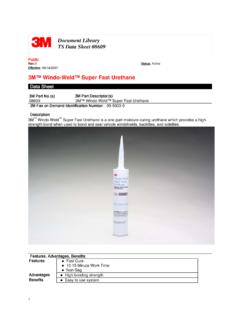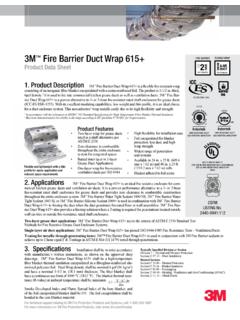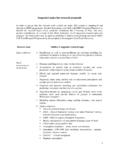Transcription of Protection for Infrasonic and Ultrasonic Noise …
1 Protection for Infrasonic andUltrasonic Noise ExposureBY ELLIOTT H. BERGERS enior Scientist, Auditory ResearchWhen Noise is assessed for its hazard-ous and/or annoying effects attention isnormally limited to frequencies within therange of audibility. However, there aresituations that arise in which acousticalenergy outside the nominal audiblerange may become important. If at thosetimes the use of hearing Protection de-vices (HPDs) is required, hearing con-servationists are at a disadvantage sinceHPD attenuation measurements con-ducted in accordance with standardizedmethods1, 2 are normally limited to the fre-quency range of 125 Hz - 8 kHz. ThisEARLog, #143, addresses the problemby not only providing extended fre-quency attenuation data for a represen-tative sample of devices, but by alsobriefly discussing suggested limits forexposure to very low and very high fre-quency acoustical the range of audible frequen-cies is classically defined as extendingfrom 20 Hz to 20 kHz, sounds of suffi-cient intensity can be aurally detected atboth lower and higher energy falling outside the "au-dible" range is designated as either in-frasonic (below approximately 20 Hz) orultrasonic (above approximately 16 - 20kHz).
2 Infrasound can be generated by bothnatural and man-made events. Ex-amples of the former are thunder, volca-nic activity, winds, large waterfalls andthe impact of ocean waves, whereasexamples of the latter are high-poweredaircraft and rocket propulsion systems,explosions, sonic booms, bridge vibra-tion, ships, and air heating and coolingequipment4. Airborne ultrasound can begenerated by a wide variety of industrialprocesses, including cleaning, drilling,welding plastics, mixing, and emulsifi-cation. Infra- and Ultrasonic acousticalenergy do not usually occur in the ab-sence of sounds within the nominal au-dible range due to the nature of the pro-cesses by which such sounds are in a comprehensive series of technical monographs covering topics related to hearing and hearing LimitsCurrently, there are no or interna-tional standards defining permissibleexposure limits to infrasound.
3 However,von Gierke and Nixon present an excel-lent review of the topic area4. Since theyfound that "infrasound, which is not sub-jectively perceived in some way, has noeffect on performance, comfort, or gen-eral well-being," they developed pro-posed limits with respect to the safetyand preservation of the auditory 8-hr. exposure limits range from136 dB at a low frequency of 1 Hz to 123dB at the upper end of the infrasonicLOW FREQUENCYEARMUFF ATTENUATION*FREQUENCY (Hz)Figure 1 ATTENUATION (dB)-10010203040501357 9204060 80 100300500246 8 103050 70 90200400 Earmuff AEarmuff BEarmuff C*From Nixon, et The discontinuity at 25 Hz maybe traced to separate experiments, in differentfacilities, for the two frequency (20 Hz). The limits may be approxi-mately adjusted for shorter or longerduration exposures using a 3-dB ex-change rate, if the duration is halved,the level may be increased by 3 dB, andvice limits to airborne ultrasoundhave been recommended by a numberof national and international organiza-tions5.
4 The available data and the expo-sure criteria have been reviewed andsummarized by Acton5 6. The criteria aresimilar, typically limiting exposures to 110dB SPL for the frequencies at and above20 kHzs 5,7, which has been translated toa 1/3 octave band criterion of 110 dBEXTENDED FREQUENCYDATA: EARPLUGSFREQUENCY (kHz)Figure 2 REAL-EAR ATTENUATION (dB)STANDARD DEVIATION (dB)NRRfiberglass w/taut sheath14premolded (V-51R)14premolded (3-flange)20partial insertion foam17standard insertion . LimitSTD. for the bands at and above 25 kHz,and 75 dB SPL for the 20-kHz 1/3 oc-tave criteria for the high audio frequen-cies (up to approximately 18 kHz) arebased upon subjective and psychologi-cal rather than auditory effects - an un-pleasant sensation of fullness or pres-sure in the ears, headaches, in-headlocalization9, and possibly nausea andfatigue - since they are the more sensi-tive indicators of potential harm in thatrange.
5 Above 18 kHz the limits are in-tended to avoid potential hearing loss inthe audio frequency region that couldresult from the generation of lower fre-quency aural distortion due to high levelultrasonic Noise . The severity of the sub-jective effects is mainly dependent uponsound level rather than exposure dura-tion, and the aural distortion phenom-ena result from nonlinear it is questionable whether ultrasonicexposure criteria are amenable to ad-justment via an exchange relationshipsuch as the 3-dB rule5, although somegroups have made such A RLog is a registered trademark of Aearo Company. Copyright 1996. First printing 1984 LIT. CODE 30306 10/96 AGHPD Attenuation At Low Audio andInfrasonic FrequenciesIn the frequency range below 50 Hzavailable attenuation data appear to belimited to only one study10. The authorsutilized both subjective (real-ear attenu-ation at threshold, 35 - 500 Hz) and physi-cal (microphone in earmuff, 1 - 500 Hz)measurement methods.
6 Representativedata are shown in Figure 1. They indi-cate generally constant attenuation from30 Hz to 100 Hz, with very limited pro-tection or even amplification for the in-frasonic frequencies. The data confirmedsubjective impressions also reported bythe measurements were conducted oninsert-type protectors, but subjective re-ports that were cited10 suggested that atightly sealed earplug could provide ap-preciable attenuation, as would alsohave been predicted based upon earlytheoretical most test standards do not re-quire testing below 125 Hz, many au-thors have reported data in the 50 - 125Hz range. Data from our laboratory12 aredepicted in Figures 2, 3, and 4 for insertsemi-aural, and circumaural HPDs. Theresults, extending down to the 80-Hz 1/3octave band may be compared to thestandard test frequency results which arealso shown. All of these data, measuredin conformance with ASA STD 1, indi-cate that the 80- and 125-Hz values aresubstantially Attenuation At High Audio andUltrasonic FrequenciesAt the upper end of the audio range hear-ing sensitivity decreases at the rate ofapproximately 100 dB/octave, comparedEXTENDED FREQUENCYDATA: SEMI-AURALSFREQUENCY (kHz)Figure 3 REAL-EAR ATTENUATION (dB)STANDARD DEVIATION (dB)NRRair-filled pod14foam-filled.
7 LimitSTD. 10 - 20 dB/octave (as frequency de-creases) for low audio and Infrasonic fre-quencies. This fact, combined with therelatively good inherent attenuation ofHPDs at high frequencies, makes gen-eration of Ultrasonic acoustical stimuli atlevels sufficient to be detected by hear-ing protected test subjects very of this writing there do not appear tobe any studies reporting HPD perfor-mance at Ultrasonic frequencies and onlytwo that even discuss the range above 8kHz12 published data12 com-bined with recent results from our labo-ratory are plotted in Figures 2 - 4. HPDswere fitted by the subjects under experi-menter supervision. The fitting of the vi-nyl foam earplug was an exception inthat it was tested with two distinctly dif-ferent experimenter insertions: partial(about 15 - 20% in the ear canal) andstandard (typical laboratory fit with 50 -60% in the canal).
8 The data extend up to the 16-kHz 1/3octave band, which includes energy kHz. The bold line at the bottom ofthe graphs represents an estimate of thebone conduction (BC) limits to HPD for the 3-flange earplug, stan-dard-insertion foam plug, and semi-au-ral data, the 8-kHz attenuation approxi-mates that at and 16 kHz. For thetwo earplugs mentioned, the highest fre-quency test data are 8 - 9 dB less than at8-kHz. This is probably attributable to thenearness with which the attenuation ofthose plugs approaches the BC limitswhich exhibit the same apparent behav-ior in that test also evaluated an earplug plusearmuff combination and found that inthe frequency range from 2 - 16 kHz themeasured performance was essentiallyequal to the BC attenuation at low audio frequen-cies (down to 50 Hz) can be estimated toan accuracy of approximately 5 dB byassuming it is equal to 125-Hz data.
9 Athigh audio frequencies (up to kHz)all HPDs tested were very effective, pro-viding at least 32 dB Noise , at those frequencies, exact esti-mation of attenuation becomes some-what Infrasonic frequencies earmuffs pro-vide little or no Protection and may evenamplify sound, whereas properly fittedimperforate earplugs should provide ap-preciable Protection . No Ultrasonic HPDEXTENDED FREQUENCYDATA: EARMUFFSFREQUENCY (kHz)Figure 4 REAL-EAR ATTENUATION (dB)STANDARD DEVIATION (dB) . LimitSTD. ATTN.*Internal earmuff cup volumeNRRmuff #1 (liquid cushion, 190 cm3*)19muff #2 (liquid cushion, 107 cm3)20muff #3 (foam cushion, 336 cm3)25muff #4 (foam cushion, 194 cm3)26attenuation data are available, but itwould be reasonable to assume that thegeneral behavior observed in the highaudio range should prevail at frequen-cies up through 32 and Footnotes1. Acoustical Society of America (1975).
10 "Method for theMeasurement of Real-Ear Protection of HearingProtectors and Physical Attenuation of Earmuffs,"Standard ASA STD 1- 1975 (ANSI ), NewYork, International Organization for Standardization (1981). Acoustics Measurement of Sound Attenuation ofHearing Protectors -Subjective Method," ISO 4869, Berger, - The EARLog series is available uponrequestfrom Aearo von Gierke, and Nixon, (1976). "Effects ofIntense Intrasound on Man" in Infrasound and LowFrequency Vibration, edited by W. TempestAcademic Press, New York, NY, Acton, (1983). " exposure to Industrial Ultrasound:Hazards, Appraisal, and Control," J. Soc. 33, Acton, (1974). "The Effects of Industrial AirborneUltrasound on Humans," Ultrasonics 12, International Radiation Protection Association (1984).Interim Guidelines on Limits of Human exposure toAirborne Ultrasound," Health Phys. 46(4), The much lower limit for 20 kHz results from the factthat the nominal bandwidth of a 1/3 octave centeredat 20 kHz extends down to kHz, within the upperend of the audible frequency The perception that occurs when environmentalnoises appear to emanate from within the head Nixon, , Hille, and Kettler, (1967).
